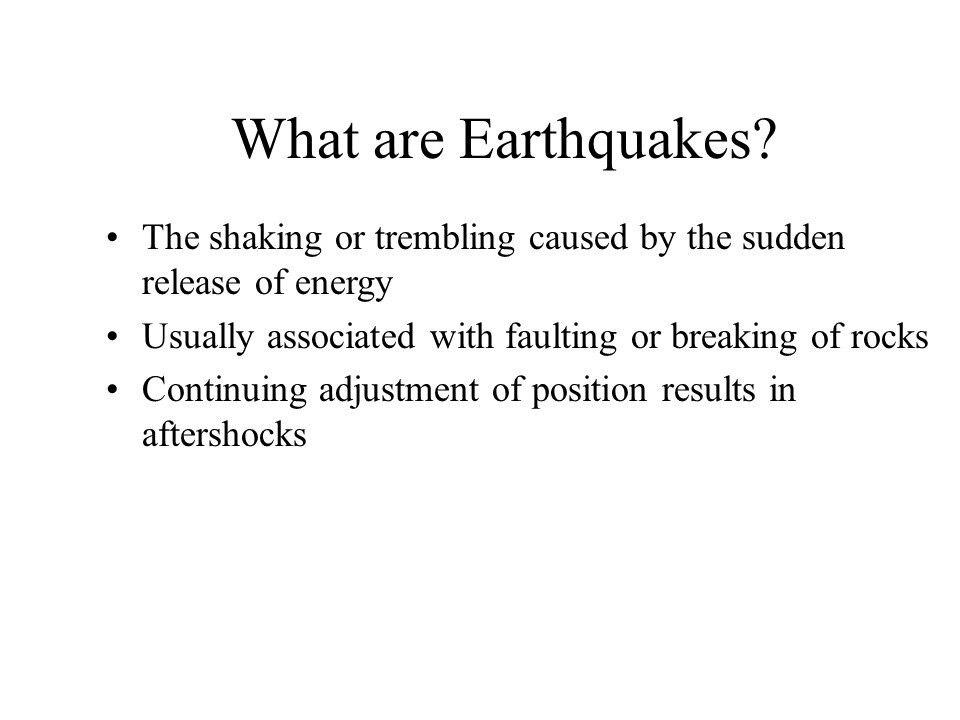Premium Only Content

What are Earthquakes? |General Knowledge
What are Earthquakes
The shaking or trembling
caused by the sudden release of energy
Usually associated with faulting or breaking of rocks
Continuing adjustment of position
results in aftershocks
What is the Elastic Rebound Theory
Explains how energy is stored in rocks
Rock's bend
until the strength of the rock is exceeded
Rupture occurs
and the rocks quickly rebound to an undiformed shape
Energy is released in waves
that radiate outward from the fault
The Focus and Epicenter of an Earthquake
The point within Earth where faulting begins
is the focus
or hypocenter
The point directly above the focus on the surface
is the epicenter
Seismographs record earthquake events
At convergent boundaries
focal depth increases along a dipping seismic zone
called a Banioff zone
Where do Earthquakes occur and how often
80% of all earthquakes occur in the Circum Pacific Belt
most of these result from convergent margin activity
15% occur in the mediter inian Asiatic belt
remaining 5% occur in the interiors of plates
and on spreading rib centers more
than 150,000 Quake Saint
The Economics and Societal Impacts of EQs
Building Collapse
Fire
Tsunami
Ground failure
What are Seismic Waves
Response of material to the arrival of
energy fronts released by rupture.
Two types Body waves P&S
Surface waves, R & L Body
Body Waves: P and S waves
Body waves
P or primary waves
fastest waves
travel through solids, liquids, or gases
Compressional wave
material movement is in the same
direction as wave movement.
S or secondary waves
Slower than P waves
travel through solids Only
shear waves move material perpendicular
to wave movement
Surface waves, R&L waves
Surface waves travel just below or
along the ground's surface
Slower than body waves; rolling and side to side
movement
Especially damaging to buildings
How is and Earthquake's epicenter located?
Seismic wave behavior? P waves arrive first, then S
waves, then L&R. Average speeds for
all these waves is known
After an earthquake, the difference in arrival
times at a seismograph station can be
used to calculate the distance from the
seismograph to the epicenter.
Times distance graph showing the average
travel times for P & S waves. The farther away a
seismograph is from the focus of an
earthquake, the longer the interval
between the arrivals of the P&S waves
Three seismograph stations are needed to
locate the epicenter of an earthquake.
A circle where the radius equals the
distance to the epicenter is drawn.
The intersection of the circles locates the
epicenter.
How are the size and strength of an
Earthquake Measured?
Intensity
subjective measure of the kind of damage
done and people's reactions to it.
Isoseismal lines identify areas of equal intensity
Magnitude
Ritcher scale measures total amount of energy
released by an earthquake independent of intensity
Amplitude of the largest wave produced by
an event is corrected for distance and assigned
on an open-ended logarithmic scale.
What are the Destructive Effects of Earthquakes?
Ground Shaking
amplitude, duration, and damage increases in poorly
consolidated rocks
Can Earthquakes be Predicted?
Earthquakes Precursors
Changes in elevation or tilting of land, Surface,
fluctuations in groundwater levels, magnetic field
electrical resistance of the ground
Seismic dilatancy model,
seismic gaps
Earthquake Prediction Programs
Include laboratory and field studies of rocks before
during and after earthquakes
monitor activity along major faults
produce risk assessments
Can Earthquakes be controlled?
Graph showing the relationship between the
amount of waste injected into wells per month
and the average number of Denver earthquakes per
month
Some have suggested that pumping fluids into
seismic gaps will cause small earthquakes while
preventing large ones.
-
 LIVE
LIVE
Matt Kohrs
12 hours agoRumble CEO Chris Pavlovski Talks $775M Tether Partnership || The MK Show
2,616 watching -
 28:23
28:23
Dave Portnoy
12 hours agoDavey Day Trader Presented by Kraken - December 23, 2024
55.3K24 -
 59:29
59:29
BonginoReport
3 hours agoTrump, Murder Plots, and the Christmas Miracle: Evita + Jack Posobiec (Ep.110) - 12/23/2024
51.8K53 -
 LIVE
LIVE
Wendy Bell Radio
6 hours agoNothing To See Here
10,904 watching -
 2:12:18
2:12:18
TheDozenPodcast
22 hours agoIslam vs Christianity: Bob of Speakers' Corner
55.7K15 -
 14:36
14:36
The StoneZONE with Roger Stone
1 day agoRoger Stone Delivers Riveting Speech at Turning Point’s AMFEST 2024 | FULL SPEECH
72.4K23 -
 18:59
18:59
Fit'n Fire
12 hours ago $5.13 earnedZenith ZF5 The Best MP5 Clone available
35.5K1 -
 58:34
58:34
Rethinking the Dollar
21 hours agoTrump Faces 'Big Mess' Ahead | RTD News Update
31.2K5 -
 5:35
5:35
Dermatologist Dr. Dustin Portela
21 hours ago $1.63 earnedUnboxing Neutrogena PR Box: Skincare Products and Surprises!
24.5K3 -
 11:20
11:20
China Uncensored
20 hours agoCan the US Exploit a Rift Between China and Russia?
54.2K20